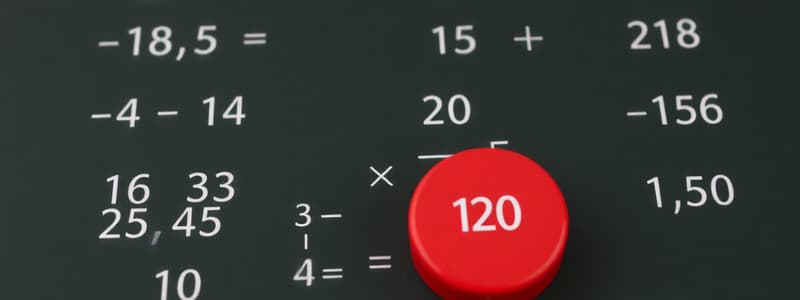Podcast
Questions and Answers
Consider the numbers 0.4599 and 0.46. Which statement accurately describes their relationship after rounding each to the nearest hundredth?
Consider the numbers 0.4599 and 0.46. Which statement accurately describes their relationship after rounding each to the nearest hundredth?
- Both numbers round to 0.45, indicating they are approximately equal when considering only tenths.
- 0.4599 rounds to 0.46 and 0.46 remains unchanged, but 0.4599 was smaller to begin with. (correct)
- Both numbers round to 0.46, suggesting they are nearly equivalent when considering hundredths.
- 0.4599 rounds to 0.45 while 0.46 remains unchanged, demonstrating a clear difference at the hundredths place.
A scientist measures two chemicals for an experiment. Chemical A weighs 0.145 grams, and Chemical B weighs 0.08 grams. Which correctly calculates the total weight of both chemicals and expresses the difference in significant figures?
A scientist measures two chemicals for an experiment. Chemical A weighs 0.145 grams, and Chemical B weighs 0.08 grams. Which correctly calculates the total weight of both chemicals and expresses the difference in significant figures?
- 0.2250 grams, adding a zero to match the number of decimal places in Chemical A's weight.
- 0.22 grams, truncating to the nearest hundredth to match the shorter decimal's precision.
- 0.23 grams, rounding to the nearest hundredth to reflect the least precise measurement. (correct)
- 0.225 grams, retaining all decimal places from the calculation.
You need to divide 17.25 by 2.5. What is the correct procedure and result?
You need to divide 17.25 by 2.5. What is the correct procedure and result?
- Both A and B are correct.
- Convert 17.25 to 1725, convert 2.5 to 25, divide to get 69.
- Convert 2.5 to 25, adjust 17.25 to 172.5, divide to get 6.9. (correct)
- Divide directly; the result is 6.9.
A recipe requires 2.25 cups of flour. You only want to make half the recipe. How many cups of flour do you need, and based on your measuring tools (measuring cups with increments of 0.25 cups), how should you practically measure it?
A recipe requires 2.25 cups of flour. You only want to make half the recipe. How many cups of flour do you need, and based on your measuring tools (measuring cups with increments of 0.25 cups), how should you practically measure it?
When converting the fraction $\frac{5}{16}$ to a decimal, the result is a repeating or terminating decimal. Identify the correct decimal representation and explain why it terminates or repeats.
When converting the fraction $\frac{5}{16}$ to a decimal, the result is a repeating or terminating decimal. Identify the correct decimal representation and explain why it terminates or repeats.
You have the repeating decimal 0.363636... where '36' repeats indefinitely. What is this decimal expressed as a simplified fraction?
You have the repeating decimal 0.363636... where '36' repeats indefinitely. What is this decimal expressed as a simplified fraction?
A store offers a discount of 15% on an item originally priced at $24.99. If sales tax is 6%, what is the final price after the discount and sales tax?
A store offers a discount of 15% on an item originally priced at $24.99. If sales tax is 6%, what is the final price after the discount and sales tax?
Consider the following expression: 3. 14 + (15.8 / 2.5) - 2.75 * 1. 2. Following the correct order of operations, what is the final result, rounded to the nearest hundredth?
Consider the following expression: 3. 14 + (15.8 / 2.5) - 2.75 * 1. 2. Following the correct order of operations, what is the final result, rounded to the nearest hundredth?
Flashcards
What are Decimals?
What are Decimals?
Numbers that include a whole number part and a fractional part, separated by a decimal point.
Decimal Place Value
Decimal Place Value
The value of a digit based on its position after the decimal point (tenths, hundredths, etc.).
Fraction to Decimal
Fraction to Decimal
Divide the numerator (top number) by the denominator (bottom number).
Decimal to Fraction
Decimal to Fraction
Signup and view all the flashcards
Comparing Decimals
Comparing Decimals
Signup and view all the flashcards
Rounding Decimals
Rounding Decimals
Signup and view all the flashcards
Adding/Subtracting Decimals
Adding/Subtracting Decimals
Signup and view all the flashcards
Multiplying Decimals
Multiplying Decimals
Signup and view all the flashcards
Study Notes
- Decimals represent numbers that are not whole numbers
- They are written using a base-10 system, separated by a decimal point
Decimal Place Values
- The position of a digit after the decimal point determines its value
- Tenths: The first digit after the decimal point (0.1)
- Hundredths: The second digit after the decimal point (0.01)
- Thousandths: The third digit after the decimal point (0.001)
- Ten-thousandths: The fourth digit after the decimal point (0.0001)
- And so on, each place being a power of 10 smaller than the previous one
Converting Fractions to Decimals
- Divide the numerator by the denominator
Converting Decimals to Fractions
- Write the decimal as a fraction with a denominator of 10, 100, 1000, etc.
- Simplify the fraction if possible
Comparing Decimals
- Start by comparing the whole number parts.
- If the whole number parts are the same, compare the tenths place, then the hundredths place, and so on.
- Add zeros to the end of shorter decimals to make comparison easier.
Rounding Decimals
- Identify the place value you are rounding to.
- Look at the digit to the right of that place value.
- If the digit is 5 or greater, round up. If it is less than 5, round down.
Adding and Subtracting Decimals
- Align the decimal points vertically.
- Add or subtract as you would with whole numbers.
- Carry or borrow as needed.
- Place the decimal point in the answer directly below the decimal points in the problem.
Multiplying Decimals
- Multiply the numbers as if they were whole numbers.
- Count the total number of decimal places in the factors.
- Place the decimal point in the product so that it has the same number of decimal places as the total counted in the factors.
Dividing Decimals
- If the divisor is a decimal, move the decimal point to the right until it becomes a whole number
- Move the decimal point in the dividend the same number of places.
- Divide as you would with whole numbers.
- Place the decimal point in the quotient directly above the decimal point in the dividend.
Word Problems Involving Decimals
- Read the problem carefully.
- Identify the key information and what you are being asked to find.
- Determine the operation needed (addition, subtraction, multiplication, division).
- Solve the problem and check your answer for reasonableness.
Studying That Suits You
Use AI to generate personalized quizzes and flashcards to suit your learning preferences.




